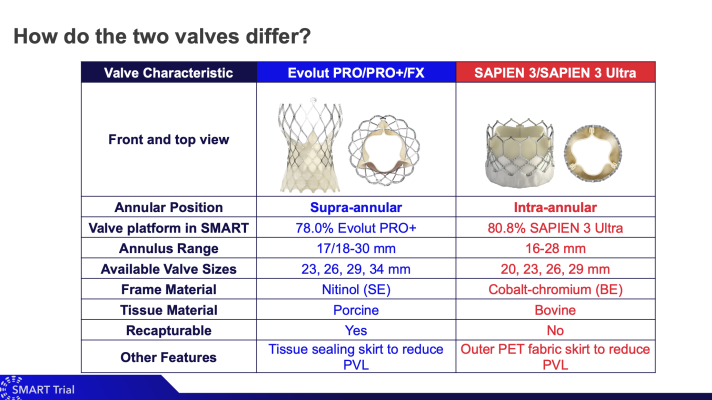
April 9, 2024 — People with a small aortic annulus, a part of the heart’s anatomy where the left ventricle meets the aorta, who underwent transcatheter aortic valve replacement (TAVR) with a supra-annular self-expanding valve saw similar clinical outcomes and superior valve performance at one year compared with those who underwent TAVR with a balloon-expandable valve, according to research presented at the American College of Cardiology’s Annual Scientific Session.
The SMART trial is the first randomized head-to-head comparison of the two most widely used TAVR devices—the supra-annular self-expanding Evolut PRO/PRO+/FX and the balloon-expandable SAPIEN 3/3 Ultra. It is also the first to focus specifically on informing device selection for patients with small aortic annuli, a patient group that is primarily women and has been underrepresented in previous clinical trials for TAVR.

Howard Herrmann, MD
“We think it’s important to study this population, which represents up to 40% of all patients getting TAVR, and it’s important to study women, who make up the majority of the small annulus population,” said Howard C. Herrmann, MD, John W. Bryfogle Professor of Cardiovascular Medicine at the Perelman School of Medicine at the University of Pennsylvania, section chief for interventional cardiology at the Hospital of the University of Pennsylvania and the study’s lead author. “There was a huge difference— 32.2 percentage points—in one-year bioprosthetic valve dysfunction favoring the Evolut platform. The magnitude of the hemodynamics difference was larger than we expected.”
TAVR is a procedure to replace an aortic valve that has become too narrow and does not fully open, forcing the heart to work harder to pump blood. A new valve is inserted through a catheter threaded through a blood vessel, most often in the leg, and put in place without removing the existing valve.
The trial enrolled 716 patients who underwent TAVR at 83 international sites in North America, Europe and the Middle East. Patients had a valve annulus of 430 mm2 or less and anatomy suitable for either the Evolut PRO/PRO+/FX or the SAPIEN 3/3 Ultra. Eighty-seven percent of study participants were women and participants were considered to face a low to intermediate risk of serious cardiac events in a baseline risk assessment.
Half of the participants were randomly assigned to receive the self-expanding Evolut valve, which is constructed using porcine tissue and materials that allow the valve to expand to full size when it reaches body temperature. The other half of participants received the balloon-expandable SAPIEN valve, which is made from bovine tissue and inserted inside the heart valve by using a balloon to expand to full size.
At one year, the trial met both primary endpoints. Researchers found no significant difference between groups in terms of a composite of death, disabling stroke or rehospitalization for heart failure—which occurred in 9.4% of patients who received the Evolut valve and 10.6% of those receiving the SAPIEN valve. In addition, the Evolut valve was found superior in terms of valve function, defined in terms of a composite of structural and non-structural valve deterioration, blood clotting around the valve, infection of the valve and aortic valve reintervention. This composite valve function endpoint occurred in 9.4% of patients who received the Evolut valve and 41.6% of those receiving the SAPIEN valve.
All pre-specified secondary endpoints were statistically significant in favor of the self-expanding valve, including the blood pressure across the valve and the size of the valve opening. Herrmann said that the supra-annular design of the self-expanding valve likely accounts for the superior hemodynamics observed in the study, since it allowed for implantation of valves with a larger opening than the balloon-expandable platform.
Researchers said the results are reassuring in terms of the clinical outcomes of both valve types and noted that further follow-up could help to shed light on how the two devices perform in this patient population in the long-term when the difference in valve function may affect how long the valve lasts. Researchers will continue to track outcomes over the next five years.
“The fact that we had similar clinical outcomes at one year is an important finding because a lot of people think one valve is better than the other, and here in a randomized trial, at least at one year in a subset of patients, the clinical differences weren’t different,” Herrmann said. “The trial gives us a ton of information. Clinically, at one year, either valve is reasonable, and the results are pretty similar, although mild valve leaks and some measures of quality of life were better with Evolut. Furthermore, this is the first time we get to identify differences between the devices that might impact later patient outcomes.”
Similar results were seen across all subgroups, although the researchers plan to analyze additional subgroups to determine whether valve performance or clinical outcomes may vary among people in different age groups or among people with different comorbidities or annulus size. They also plan to assess measures of valve durability over time, which Herrmann said is becoming more important as younger patients are increasingly undergoing TAVR.
The study was funded by Medtronic, Inc., maker of the Evolut PRO/PRO+/FX. This study was simultaneously published online in the New England Journal of Medicine at the time of presentation.
For more information: www.acc.org


 April 11, 2024
April 11, 2024 








